Inbox and Environment News - Issue 246
January 10 - 16, 2016: Issue 246
Review of Medicare Benefits Schedule
28 December 2015 – Media Release: The Hon Sussan Ley MP; Minister for Health, Minister for Aged Care, Minister for Sport
The Government is committed to working with health professionals and patients to build a Medicare Benefits Schedule that is based on contemporary clinical practice.
This is evidenced by our clinician-led Taskforce reviewing all 5700 items on the MBS, many of which have not been updated or assessed in decades, or at all.
Recent public consultation undertaken as part of the MBS Taskforce’s work demonstrates the important support amongst health professionals for this clinical process, with over 93 per cent surveyed agreeing parts of the MBS were out-of-date and required review.
This intensive work is being undertaking in stages over a 2 year period, with the MBS Taskforce’s first round of advice now available for public consultation until 8 February 2015 here
This first stage of work has provided recommendations about the immediate removal of lower-volume MBS items in some specific specialities where there is clinical consensus that they are ‘obsolete’ and no longer represent clinical best-practice. These are also items that clinical experts deem will not have adverse impacts on a patient’s access to health services if removed.
Reasons range from more-clinically appropriate and/or efficient technologies and procedures already listed on the MBS through to patient safety, unnecessary doubling-up of item claims and decreasing usage.
For example, in diagnostic imaging, invasive tests to diagnose blood clots in the lower leg or gall bladder problems have now been replaced by non-invasive ultrasound technology.
There are 23 MBS items in total recommended for removal in this first stage of work from a handful of specialities, including:
• Diagnostic imaging – 7 items
• Ear, nose, and throat surgery – 9 items
• Gastroenterology – 5 items
• Obstetrics – 1 item
• Thoracic medicine – 1 item
These 23 MBS items were used a combined total of 52,500 times in 2014-15, worth $6.8 million in Medicare benefits paid.
As part of our commitment to consultation throughout this process, the Taskforce will now seek further views on the 23 MBS items they have recommended for removal before final decisions are made.
It is important to understand that this is not by any means a comprehensive or complete list of final findings about the final makeup of the MBS.
Never has such a comprehensive review of all 5700 items on the MBS been undertaken since Medicare’s inception in the 1980s and many more items will require more in-depth, complex evaluation.
It is also important to remember further advice from the Taskforce will not just focus on the removal of items from the MBS altogether, but also maintaining clinically-relevant MBS items, the addition of new MBS items where appropriate, and more intricate changes around the rules governing the eligibility and use of an MBS item for a particular patient cohort.
The work of the MBS Review is part of the Turnbull Government’s commitment to an integrated approach to health policy development and complements our concurrent review of primary health care and policy work to improve private health insurance for consumers, as well as our bold plans to transform mental health service delivery.
My number one priority for this MBS review has always been, and remains, building a healthier Medicare for Australian patients, health professionals and taxpayers and I am determined to deliver it.
Twenty new freshwater fish species uncovered in Australia
January 6, 2016
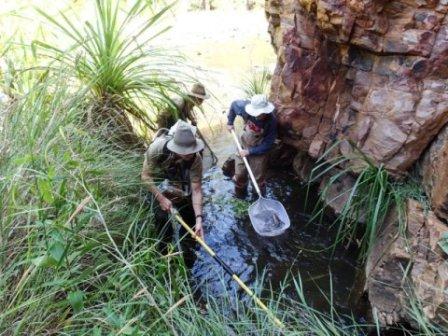
Researchers have discovered 20 new species of freshwater fish during field work in the remote Kimberley region of Western Australia. Credit: The University of Melbourne
It is the single greatest addition to the country's freshwater fish inventory since records began and boosts the total number of known species in Australia by almost ten per cent.
The research team included Associate Professor Tim Dempster, Professor Stephen Swearer, James Shelley, Matthew Le Feuvre (University of Melbourne), Dr Martin Gomon (Museum Victoria) and Dr Michael Hammer (NT Museum).
Team leader Dr Tim Dempster, from the University of Melbourne's School of BioSciences, says the discovery highlights the hidden wealth of biodiversity within the Kimberley.
"The freshwater ecosystems of the Kimberley are among the poorest known and least researched areas of Australia," Dr Dempster said.
"If we can double the number of known fish species unique to the Kimberley in just three years, it can only mean the entire biodiversity of life in Kimberley rivers is underestimated.
"Certainly, it is a treasure trove for freshwater fish -- and the amazing thing is that we weren't even looking for it."
Dr Dempster's researchers were in the Kimberley to study the extinction risks for the region's existing freshwater fish, results of which have just been published in the journal Global Ecology and Biogeography.
Lead author of the paper, Matthew Le Feuvre said "many of the 18 known and 20 newly discovered species unique to the Kimberley share similar characteristics with fish species elsewhere in Australia that are conservation listed as vulnerable, threatened or endangered.
"However, currently no fish species in the Kimberley are conservation-listed, despite their potential vulnerability."
The new species were discovered during nine months of fieldwork across 17 Kimberley rivers between 2012 and 2014.
Twelve of the 20 species were discovered within a three-week period in 2013 by James Shelley and Matthew Le Feuvre when they accessed some of the most remote rivers in Australia by helicopter.
Sampling was challenging, with Mr Shelley attacked by a freshwater crocodile while snorkeling in the Glenelg river on the Kimberley plateau.
The new species fall within three categories:
Terapontidae (grunters) 16 new species
Eleotridae (gudgeons) three new species
Atherinidae (hardy heads) one new species.
One of the new species -- a 25cm-long grunter found in the remote and spectacular Prince Regent River -- is set to be named after writer and novelist Tim Winton.
"It's in recognition of his contribution to Australia's cultural life, his love of fish which shines through in many of his novels, and his staunch advocacy for conservation in the Kimberley," Mr Shelley said.
Mr Winton said it was "surprisingly gratifying" to have his name attached to a new species of fish.
"The Kimberley is a treasure that clearly requires more study and greater protection and groundbreaking discoveries like these underline just how much there is still to learn about this special region," Mr Winton said.
All the remaining new species will receive a common name reflecting the aboriginal name for the area it was collected from or words describing its features, as well as a Latin scientific name.
The research team hopes the discovery strengthens conservation efforts in the Kimberley.
"Fish are just the tip of the iceberg," he said.
"This discovery has major implications for conservation, particularly in light of the Federal Government's moves to modify water resources in northern Australia," he said.
"A lot of these new fish species are unique to just one catchment, so they're particularly vulnerable if there is a change to their limited habitat."
Matthew C. Le Feuvre, Tim Dempster, James J. Shelley, Stephen E. Swearer. Macroecological relationships reveal conservation hotspots and extinction-prone species in Australia's freshwater fishes. Global Ecology and Biogeography, 2016; 25 (2): 176 DOI:10.1111/geb.12397

Pittwater's Wildlife Protection Areas
Pittwater is a very biodiverse area and currently has 25 declared Wildlife Protection Areas (WPAs) established in accordance with the NSW Companion Animals Act 1998. This is in recognition that these areas are of significant ecological value and provide vital habitat for native fauna.
A list of WPAs in Pittwater may be found atwww.pittwater.nsw.gov.au/wpas
Cats are prohibited in ALL Wildlife Protection Areas whilst dogs are prohibited in Bangalley Head, Deep Creek Foreshore Reserve, Turimetta Headland, Ingleside Chase Reserve, Irrawong Reserve, Warriewood Wetlands, and Careel Bay Intertidal Area. In all other WPAs dogs are permitted provided they are on a lead and remain on the designated path.
Early in the new year Pittwater Council will commence a trial program to manage cats in a select number of Wildlife Protection Areas. These have been selected because of high diversity and reported issues with cats. Residents adjacent to these reserves will be notified prior to program commencement and signage installed at all reserve entrances. During the program period, cats found roaming these areas will be taken to the Pittwater Animal Hospital. All cat owners are encouraged to ensure their pets are microchipped, registered with Council and correct contact details are maintained.
Owners of cats found within WPAs are liable for fines.
It is not only our wildlife that benefit from keeping domestic and feral animals out of WPAs it is our pets themselves. This keeps them safe from ticks, snakes and spiders, prevents injuries caused by fighting with other domestic animals or native fauna, reduces the likelihood of contracting diseases and minimises the risk of being hit by a motor vehicle.
Native wildlife is particularly vulnerable to cat and dog predation as they have no effective defence mechanisms against introduced predators or infections or diseases (e.g. toxoplasmosis) associated with injury. Council looks forward to working with the community to ensure these Wildlife Protection Areas remain a safe haven for our precious native fauna.
For more information please contact Sonja Elwood on 9970 1308.
Grevillea Caleyi Seed Collection at Ingleside: PNHA
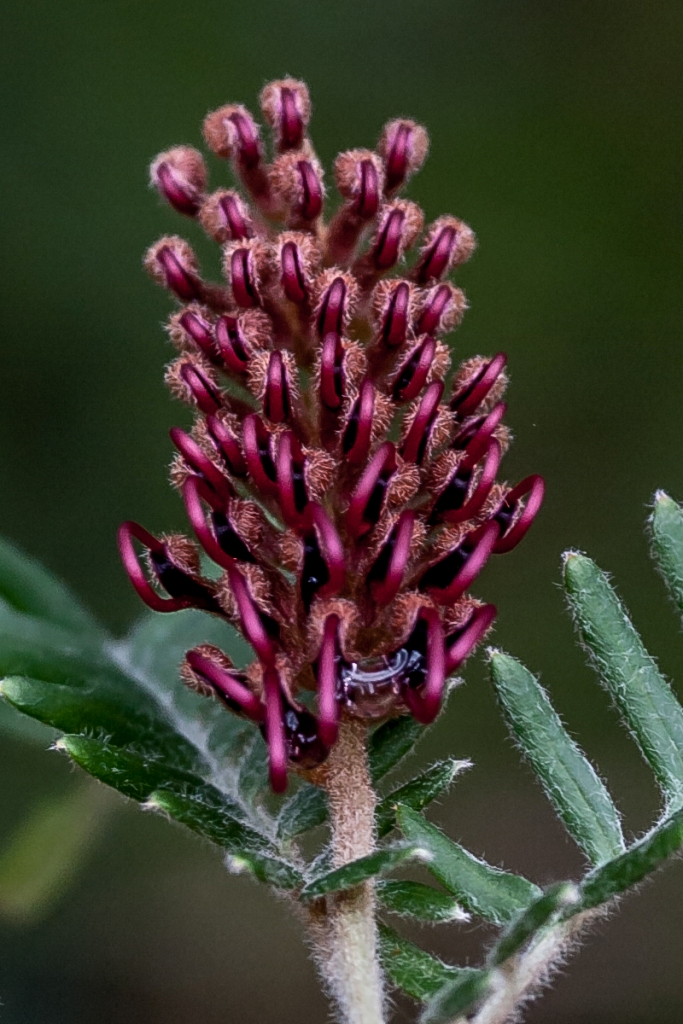
Volunteers at the Pittwater Natural Heritage Association (PNHA) bush regeneration project at the Baha’i Temple, Ingleside had a special demonstratio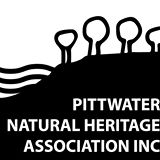 n at their December bushcare morning when staff of the Royal Botanic Gardens undertook collection of seeds from the critically endangeredGrevillea caleyi.
n at their December bushcare morning when staff of the Royal Botanic Gardens undertook collection of seeds from the critically endangeredGrevillea caleyi.
Grevillea caleyi is restricted to small pockets within the Terrey Hills, Duffys Forest, Belrose and Ingleside areas. The Royal Botanic Gardens will be collecting seed from these sites for storage in the Australian PlantBank at the Mount Annan Australian Botanic Garden to provide long term back-up in case of any loss that may occur to the species in its natural habitat.
Meanwhile the PNHA bush regeneration project continues, with the dedicated team of volunteers including members of the Baha’i congregation working alongside professional bush regenerators to give this population of Grevillea caleyi a chance to increase.
They welcome new volunteers, so if you are interested in helping on the project in 2016 call David Palmer on 0404 171 940.
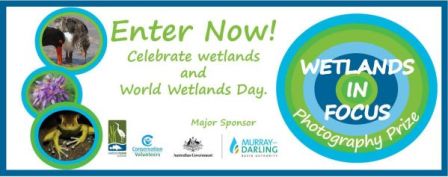
WetlandCare Australia and Conservation Volunteers Australia invite photographers of all ages to enter the Wetlands in Focus photography prize.
Join us in celebrating and sharing Australia’s wonderful wetlands and waterways!
It’s easy and free to enter and get involved – just capture your favorite Australian wetland flora (plant), fauna (animal) or landscape on camera, and submit your shot in the easy to use form on the Wetland Care Australia website.
There’s even a category for photos of wetland volunteers in action, the perfect way to showcase the hard work and dedication of wetland carers around the nation.
All entries will be publicly displayed, with Entrant’s Name, Entry Title, Artists Statement and category entered into, on the WetlandCare Australia Facebook page where you and all your friends can vote for the People’s Choice Prize by liking your fave photo.
Wetlands in Focus is dedicated to spreading the word about Australia’s amazing wetlands and the fantastic people like you who care about them.
Entries are open right up to the end of February 2016, which will be a month of wetland celebrations and events, marking World Wetlands Day.
Entries close February 29 2016, voting for the People's Choice closes March 3 2016.
World Wetlands Day falls on February 2nd each year and commemorates the anniversary of the signing of the Ramsar Convention on Wetlands of International Importance on the 2nd February 1971.
The theme for World Wetlands Day 2016 is Wetlands for our Future: Sustainable Livelihoods
There will be wetland themed events happening in locations around Australia during February 2016, watch this space for more details!
For Prize Details and to Enter visit the Wetland Care Australia website.
Annual climate statement 2015
Issued Wednesday 6 January 2016: BoM
Introduction
2015 was Australia's fifth-warmest year on record, while national rainfall was slightly below average according to data collected and analysed by the Bureau of Meteorology.
2015 was another warm year, especially during the last three months
Strong El Niño, comparable to the El Niño events of 1997–98 and 1982–83
Overall, it was Australia's fifth-warmest year on record with the annual national mean temperature 0.83 °C above average
Warmest October on record nationally, for both maxima and minima, with the largest mean temperature anomaly on record for any month
Western Australia, Queensland, Victoria, South Australia, and New South Wales ranked in the ten warmest years on record
Nationally-averaged rainfall 5% below average for the year, at 443.7 mm (1961–1990 average 465.2 mm)
Rainfall below average for parts of the Top End, most of Queensland, Victoria, Tasmania, southeast and western South Australia, and southwest Western Australia
Rainfall above average for the Gascoyne and Pilbara in Western Australia, most of the central Northern Territory, northeastern South Australia, and northwestern New South Wales
Overview
2015 was Australia's fifth-warmest year on record (national observations commence in 1910). Above average temperatures were persistent throughout the year, with several periods of record warmth.
The Australian area-averaged mean temperature for 2015 was 0.83 °C above the 1961–1990 average. Maximum temperatures were 0.96 °C above average, and minimum temperatures were 0.69 °C above average; both the sixth-warmest on record respectively.
Looking at recent years more broadly, eight of Australia's ten warmest years on record have occurred since 2002. The 10-year mean temperature for 2006–2015 was the second highest on record at 0.53 °C above average (and just behind 2005–2014). Only one year in the past ten was cooler than average: 2011.
Annual mean temperatures for 2015 were above to very much above average for the majority of Australia, although much of the central Northern Territory and northwest of the Kimberley in Western Australia observed a near-average annual mean temperature.
After a near miss in 2014, El Niño became established during May and strengthened to become one of the strongest on record (alongside 1972–73, 1982–83 and 1997–98). The combination of El Niño and background warming led to very warm temperatures globally throughout 2015, and contributed to Australia's warm year.
El Niño also led to below average rainfall over much of eastern Australia, although record-warm sea surface temperatures (SSTs) in the Indian Ocean initially moderated the effect of the El Niño. Between late August and mid-November a positive Indian Ocean Dipole (IOD) had the opposite effect, reinforcing drying over much of Australia as the flow of moisture from the Indian Ocean was reduced.
The Australian mean rainfall for 2015 was 5% below the 1961–1990 climatological average of 465.2 mm. 2015 was Australia's 57th-driest year on record, with an area-average total of 443.7 mm—close to the median.
Annual rainfall was below average across most of Queensland and parts of the Northern Territory's Top End; Victoria and southeast South Australia; Tasmania; the western half of South Australia and the far southwest of the Northern Territory; and the southwest of Western Australia. Rainfall was above average for the Gascoyne and Pilbara in Western Australia; areas of the Northern Territory stretching from the western Top End, across the central region, through the southeast of the Northern Territory and across northeastern South Australia, into northwestern New South Wales; and also for small parts of the east coast between southeastern Queensland and East Gippsland in Victoria.
Water Run-off From Leewood Water Treatment Facility in Narrabi Cleaned Up
Media release: 5 January 2016 - EPA
Minor storm water run-off from Leewood Water Treatment Facility (LWTF) near Narrabi, which was reported to the NSW Environment Protection Authority’s (EPA) Environment Line on Monday 4 January 2015, has been cleaned up and the water taken away for legal disposal by a licensed waste company.
The run-off occurred after recent rain when surface water left the Santos-run site and pooled on a small area at the southern boundary of the property. Photographs provided to the EPA by the complainant showed the water contained sediment and traces of the polymer spray used for dust suppression on the internal roads of the property.
Gary Davey, Director of the EPA’s North Branch, said that there are no apparent environmental or health risks from the run-off and that the EPA would investigate to ensure that the facility had adequate erosion controls.
“The water run-off from Leewood Water Treatment Facility was minor and removed quickly. Santos is in contact with the complainant and has commenced works on site to ensure that further storm water discharges do not occur off the premises. The EPA appreciates the quick response by Santos to this issue.”
Santos is required to submit an incident report to the EPA by Friday 8 January 2016 and has also been requested to provide its Sediment and Erosion Control Plan to the EPA for review.
“The EPA expects licensee’s to comply with their licence at all times. Once the incident report and Sediment and Erosion Control Plan have been reviewed and the current on-site erosion control works have been completed, the EPA will inspect the site to assess the adequacy of the control measures. Decisions on any further regulatory action will be taken at that time,” Mr Davey said.
Good sediment and erosion controls are important to ensure that the environment and community are protected. If sediment laden waters leave a site and enter watercourses, this can have a major impact on aquatic organisms. The EPA understands that the closest water course to Leewood Water Treatment Facility is over one kilometre away.
Santos recently began construction of Leewood Phase 2. The activity is covered by Santos’ Environment Protection Licence (20350) which is publicly available on the EPA’s website.
The EPA encourages anyone who sees a pollution incident to contact the Environment Line on 131 555.
Scientists discover rare sea snakes, previously thought extinct, off Western Australia
December 21, 2015
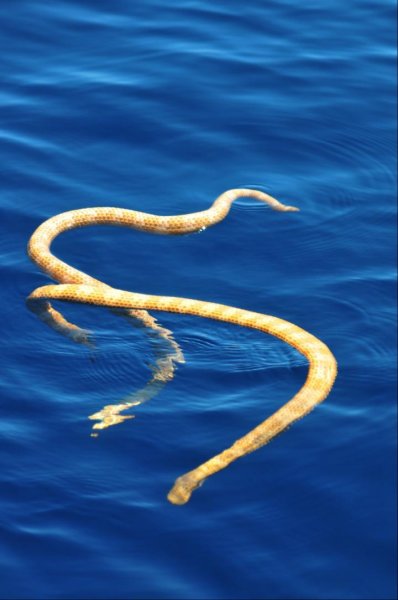
This is a photograph of the rare short nosed sea snake discovered on Ningaloo reef, Western Australia. Credit: Image: Grant Griffin, W.A. Dept. Parks and Wildlife
Scientists from James Cook University have discovered two critically endangered species of sea snakes, previously thought to be extinct, off the coast of Western Australia.
It's the first time the snakes have been spotted alive and healthy since disappearing from their only known habitat on Ashmore Reef in the Timor Sea more than fifteen years ago.
"This discovery is really exciting, we get another chance to protect these two endemic Western Australian sea snake species," says study lead author Blanche D'Anastasi from the ARC Centre of Excellence for Coral Reef Studies at JCU.
"But in order to succeed in protecting them, we will need to monitor populations as well as undertake research into understanding their biology and the threats they face."
The discovery of the critically endangered short nose sea snake was confirmed after a Western Australia Parks and Wildlife Officer, Grant Griffin, sent a photo of a pair of snakes taken on Ningaloo Reef to Ms D'Anastasi for identification.
"We were blown away, these potentially extinct snakes were there in plain sight, living on one of Australia's natural icons, Ningaloo Reef," says Ms D'Anastasi.
"What is even more exciting is that they were courting, suggesting that they are members of a breeding population."
The researchers also made another unexpected discovery, uncovering a significant population of the rare leaf scaled sea snake in the lush seagrass beds of Shark Bay.
The discovery was made 1700 kilometres south of the snakes only known habitat on Ashmore Reef.
"We had thought that this species of sea snake was only found on tropical coral reefs. Finding them in seagrass beds at Shark Bay was a real surprise," says Ms D'Anastasi.
Both leaf scaled and short nosed sea snakes are listed as Critically Endangered under Australia's threatened species legislation, which means they have special protection.
Despite the good news of the find, sea snake numbers have been declining in several marine parks, and scientists are at a loss to explain why.
"Many of the snakes in this study were collected from prawn trawl by-catch surveys, indicating that these species are vulnerable to trawling," says Dr Vimoksalehi Lukoschek from the Centre of Excellence for Coral Reef Studies.
"But the disappearance of sea snakes from Ashmore Reef, could not be attributed to trawling and remains unexplained.
"Clearly we need to identify the key threats to their survival in order to implement effective conservation strategies if we are going to protect these newly discovered coastal populations," Dr Lukoschek says.
B.R. D'Anastasi, L. van Herwerden, J.A. Hobbs, C.A. Simpfendorfer, V. Lukoschek. New range and habitat records for threatened Australian sea snakes raise challenges for conservation. Biological Conservation, February 2016; 194: 66 DOI: 10.1016/j.biocon.2015.11.032

Bushcare in Pittwater
Where we work Which day What time
Avalon
Angophora Reserve 3rd Sunday 8:30 - 11:30am
Avalon Dunes 1st Sunday 8:30 - 11:30am
Avalon Golf Course 2nd Wednesday 3 - 5:30pm
Careel Creek 4th Saturday 8:30 - 11:30am
Toongari Reserve 3rd Saturday 9 - 12noon (8 - 11am in summer)
Bangalley Headland 2nd Sunday 9 to 12noon
Bayview
Winnererremy Bay 4th Sunday 9 to 12noon
Bilgola
North Bilgola Beach 3rd Monday 9 - 12noon
Algona Reserve 1st Saturday 9 - 12noon
Plateau Park 1st Friday 8:30 - 11:30am
Church Point
Browns Bay Reserve 1st Tuesday 9 - 12noon
McCarrs Creek Reserve Contact Bushcare Officer To be confirmed
Clareville
Old Wharf Reserve 3rd Saturday 8 - 11am
Elanora
Kundibah Reserve 4th Sunday 8:30 - 11:30am
Mona Vale
Mona Vale Beach Basin 1st Saturday 8 - 11am
Mona Vale Dunes 2nd Saturday+3rd Thursday 8:30 - 11:30am
Newport
Bungan Beach 4th Sunday 9 - 12noon
Crescent Reserve 3rd Sunday 9 - 12noon
North Newport Beach 4th Saturday 8:30 - 11:30am
Porter Reserve 2nd Saturday 8 - 11am
North Narrabeen
Irrawong Reserve 3rd Saturday 2 - 5pm
Palm Beach
North Palm Beach Dunes 3rd Saturday 9 - 12noon
Scotland Island
Catherine Park 2nd Sunday 10 - 12:30pm
Elizabeth Park 1st Saturday 9 - 12noon
Pathilda Reserve 3rd Saturday 9 - 12noon
Warriewood
Warriewood Wetlands 1st Sunday 8:30 - 11:30am
Whale Beach
Norma Park 1st Friday 9 - 12noon
Western Foreshores
Coopers Point, Elvina Bay 2nd Sunday 10 - 1pm
Rocky Point, Elvina Bay 1st Monday 9 - 12noon
Restoring Bilgola - Newport Escarpment Project: 2016
Have you noticed all the bamboo being removed just past The Serpentine as you travel north along Barrenjoey Road?
These works are part of the planned removal of environmental weeds and restoration works within this catchment. Large areas that are severely degraded such as this location, will be replanted with local native species that enable a healthy natural system to respond and adapt and support the full range of our native plants and animals.
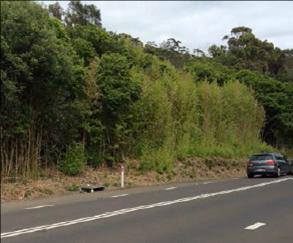
Before bamboo removal
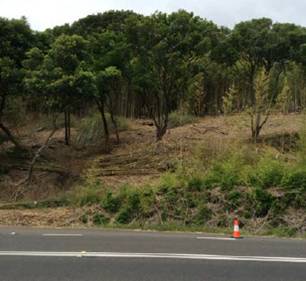
Works in progress after bamboo removal
Bush regeneration and weed control is being undertaken within the upper and lower areas of this escarpment from South Bilgola Headland down to Bilgola Surf Club and on the upper and lower bushland areas to Old Barrenjoey Road! The project is enabling major restoration works to be carried out throughout the Bilgola Newport Escarpment. The overall project has a budget of $160,000 and aims to be completed by 30 June 2016.
Two endangered native plant communities are located within the escarpment, Littoral or Coastal Rainforest and Themeda Grasslands on Coastal Headlands, as well as three other vegetation communities, making this location rich with a wide variety of native flora species.
Over 1725 local native tubestock have been grown from seed and will be planted by volunteers and bush regeneration contractors under the guidance of Council.
Would you like to help with this project?
Community residents and volunteers work at the Bilgola Beach Bushcare site on the 3rd Monday of each month from 9am – 12noon.
Can only help on the weekend?
There are several planned community planting events to be held on weekends in March and April at South Bilgola Headland and at the Bilgola Bushcare site (dates to be confirmed). Please call the Bushcare Officer if interested in participating in any events or for further details on this project call the Bushland Management Officer on 9970 1363.
Live locally? Want to help?
Simply remove all noxious and environmental weeds on your property as this will help to stop the spread of these species into our bushland areas. If you need some help to identify the weeds then call Pittwater Council or visit the website to find out more information – www.pittwater.nsw.gov.au/weeds
Pittwater Council’s ‘Bilgola Creek biodiversity’ project is supported by the Sydney Coastal Councils Group through funding from the Australian government.



NSW Container Deposit Scheme: Have Your Say
On 21 February 2015, the Premier, the Hon. Mike Baird MP, announced the implementation of a container deposit scheme (CDS) by 1 July 2017.
A container deposit scheme (CDS) uses rewards to encourage people to return their drink containers to a collection point. CDSs are a way to reward environmentally responsible behaviour, reduce drink container litter and increase recycling.
The NSW Container Deposit Scheme Discussion Paper is your opportunity to tell us what kind of CDS you would like to see in NSW.
This discussion paper has been prepared by the NSW Environment Protection Authority, on behalf of the Container Deposit Scheme Advisory Committee, appointed by the Minister for the Environment.
Have your say
Submit your feedback on the discussion paper by Friday 26 February 2016.
For more information, visit the EPA website.
Online Consultation
Date: Dec. 18, 2015 - Feb. 26, 2016, Time: 10:30pm — 12:00pm
More Information container.deposit@epa.nsw.gov.au or (02) 9995 5555 Agency Website
Community Gardens in Pittwater
Come along to Woolcott Street, Newport and join the community garden group. The garden started to take shape just before Christmas when a local resident constructed five raised garden beds. One bed is pine and the others are hardwoods sourced from the Hunter Valley. They look fabulous!
The garden beds were filled with soil three days before Christmas and by the time this goes to print, they will be full of vegetables. You are welcome to come along and join the group of gardeners at Woolcott Street, or if you live north of ‘The Bends’, you may prefer the community garden at Barrenjoey High School. Contact details for both groups are:
Woolcott Street, Newport: peninsulacommunitygarden@outlook.com
Barrenjoey High School: garden@pcga.org.au
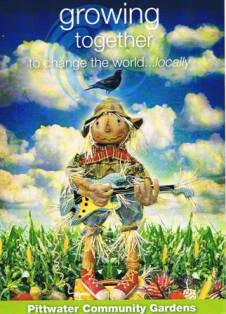 Community Gardens bring people together and enrich communities. They build a sense of place and shared connection.
Community Gardens bring people together and enrich communities. They build a sense of place and shared connection.
Pittwater Community Gardens PROFILE
Pittwater Community Gardens is a community led initiative to create accessible food gardens in public places throughout the Pittwater area. Our aim is to share skills and knowledge in creating fabulous local, organic food. But it's not just about great food. We also aim to foster community connection, stimulate creative ideas for community resilience and celebrate our abundance. Open to all ages and skills, our first garden is on the grounds of Barrenjoey High School (off
www.pcga.org.
SICK AND INJURED NATIVE ANIMALS
Hot and dry conditions that summer is known for means our native animals suffer. If you come across a native animal that is sick or injured please call one of the following rescue groups:
Sydney Wildlife 02 9413 4300
WIRES 1300 094 737
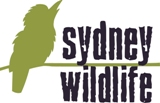
Frost Patterns - It's Winter in Northern Hemisphere
January 4th, 2015

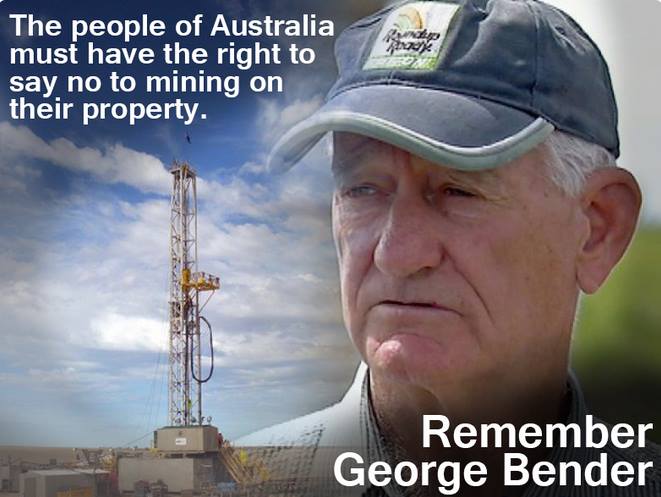
Australian National Principles: Increasing the value of environmental information
Department of the Environment Media release: 22 December 2015
The Australian Government has released new National Principles for Environmental Information to help us better collaborate on protecting our environment, society and economy.
Governments, businesses and communities which make environment-related policies and decisions will benefit from improvements to the accessibility of environmental information.
This set of broad principles has been developed to guide Australian Government information custodians on making their environmental information more discoverable, accessible and re-useable.
Opening environmental information to its broadest user base supports the transparency and efficiency of environmental decisions, and the responsiveness and effectiveness of decision-makers.
The National Principles for Environmental Information help to address the problem of environmental information holdings being fragmented and difficult to access, as a result of being collected by many people and institutions for a range of purposes.
For example, information on the distribution of threatened species is critical for decisions on the development of land. The information developed by government agencies and researchers depends on data derived from many sources, including citizen scientists, researchers, herbaria, museums, industry and government.
Initiatives such as the Atlas of Living Australia and the use of standards enable this disparate data to be made discoverable accessible and re-usable by all parties.
The National Principles for Environmental Information will guide the integration and interpretation of data gathered from different sources across Australia and internationally by many different organisations. It will also enable the rapid incorporation of data into many applications, products and decision making processes.
The Department of the Environment is committed to supporting the quality and availability of environmental information for environment managers at all levels of government and the community.
To access the principles go to The National Plan for Environmental Information Initiative or www.bom.is/enviroinfoprinciples
Reforms to Better Manage Our Coast
Planning Minister Rob Stokes today (13.11.2015) released draft reforms for consultation to make coastal management in NSW simpler, forward-thinking and easier to implement.
“The NSW Government recognises the importance of our state’s saltwater economy and we want to see thriving, resilient communities living, working and playing on a healthy coast now and into the future,” Mr Stokes said.
“We want to replace and improve on the outdated and complex web of laws managing our coast. The current Act is complex, difficult to navigate, and its one-size-fits all approach is no longer fit for purpose.
“Since the original Coastal Protection Act was enacted in 1979 our understanding of coastal processes has improved dramatically. We know our coastline is not a fixed object, but a dynamic, ever-changing environment with a range of natural processes.”
The reforms include:
• A draft Bill for a new Coastal Management Act.
• Key elements of a new Coastal Management Manual.
• Proposals for a new Coastal Management State Environmental Planning Policy (SEPP).
The draft Bill redefines the coast as four distinct areas of coastal wetlands and littoral rainforests; coastal vulnerability areas; coastal environment areas and coastal use areas to identify each area’s unique management requirements.
The manual will provide guidance to local councils and clear, step-by-step instructions to support them to manage their coast using the new Coastal Management Act.
The new SEPP will help manage the legacy of existing coastal hazards and help plan to ensure new hazards are avoided.
A three-month consultation period will run to ensure everyone has a chance to have their say. Go to www.haveyoursay.nsw.gov.au
_____________________________
Our future on the coast: NSW coastal management reforms
The public consultation package includes a draft Coastal Management Bill, an Explanation of Intended Effect for the proposed new Coastal Management State Environmental Planning Policy (SEPP), and key elements of a draft coastal management manual.
Additional elements of the proposed new framework will be released later for public comment, including further components of the manual, maps of the coastal zone that will form part of the SEPP and proposals concerning the effects of coastal erosion on coastal boundaries.
Have your say
The public is invited to read the documents for consultation and provide feedback about the new approach.
Submit feedback by 29 February 2016 via emailcoastal.reforms@environment.nsw.gov.au, online consultation form or post to:
Office of Environment and Heritage, PO Box A290 , Sydney South. NSW 1232
Worldwide electricity vulnerable to climate/water resource change
January 4, 2016
Climate change impacts and associated changes in water resources could lead to reductions in electricity production capacity for more than 60% of the power plants worldwide from 2040-2069, according to a new study published today in the journal Nature Climate Change. Yet adaptation measures focused on making power plants more efficient and flexible could mitigate much of the decline.
"Hydropower plants and thermoelectric power plants--which are nuclear, fossil-, and biomass-fueled plants converting heat to electricity--both rely on freshwater from rivers and streams," explains Michelle Van Vliet, a researcher at the International Institute for Applied Systems Analysis (IIASA) in Austria and Wageningen University in the Netherlands, who led the study. "These power-generating technologies strongly depend on water availability, and water temperature for cooling plays in addition a critical role for thermoelectric power generation."
Together, hydropower and thermoelectric power currently contribute to 98% of electricity production worldwide.
Model projections show that climate change will impact water resources availability and will increase water temperatures in many regions of the world. A previous study by the researchers showed that reduced summer water availability and higher water temperatures associated with climate change could result in significant reductions in thermoelectric power supply in Europe and the United States.
This new study expands the research to a global level, using data from 24,515 hydropower and 1,427 thermoelectric power plants worldwide.
"This is the first study of its kind to examine the linkages between climate change, water resources, and electricity production on a global scale. We clearly show that power plants are not only causing climate change, but they might also be affected in major ways by climate," says IIASA Energy Program Director Keywan Riahi, a study co-author.
"In particular the United States, southern South America, southern Africa, central and southern Europe, Southeast Asia and southern Australia are vulnerable regions, because declines in mean annual streamflow are projected combined with strong increases in water temperature under changing climate. This reduces the potential for both hydropower and thermoelectric power generation in these regions," says Van Vliet.
The study also explored the potential impact of adaptation measures such as technological developments that increase power plant efficiency, switching from coal to more efficient gas-fired plants, or switching from freshwater cooling to air cooling or to seawater cooling systems for power plants on the coasts.
"We show that technological developments with increases in power plant efficiencies and changes in cooling system types would reduce the vulnerability to water constraints in most regions. Improved cross-sectoral water management during drought periods is of course also important," says Van Vliet. "In order to sustain water and energy security in the next decades, the electricity focus will need to increase their focus on climate change adaptation in addition to mitigation."
Michelle T. H. van Vliet, David Wiberg, Sylvain Leduc, Keywan Riahi.Power-generation system vulnerability and adaptation to changes in climate and water resources. Nature Climate Change, 2016; DOI:10.1038/NCLIMATE2903
Have your say on a new sand quarry in Williamtown
Date: 04.12.2015: Departmental Media Release -Department of Planning and Environment
A proposal to construct a new sand quarry in Cabbage Tree Road, Williamtown will be on exhibition from today for community feedback.
The Department of Planning and Environment is keen to hear the community’s views on the application which seeks to:
construct and operate a sand quarry to extract up to 600,000 tonnes per year from a total amount of 3.32 million tonnes
clear 53.9 hectares of vegetation
carry out mobile screening and dry processing on site
construct associated infrastructure including:
roads for site access; an office; amenity buildings; weighbridge; staff and visitor parking; maintenance shed; transport processed material off-site via public roads; progressively rehabilitate the site.
A spokesperson for the Department of Planning and Environment said the local community always has an opportunity to share their views.
“Community consultation is an integral part of the planning process and the applicant will have to respond to the feedback we receive and this is taken into consideration when we develop our recommendations,” the spokesperson said.
“It’s easy to participate by going online and we encourage everyone to take a look and have their say.”
To make a submission or view the Environmental Impact Statement (EIS), visit www.majorprojects.planning.nsw.gov.au.
Submissions can be made from Friday 4 December 2015 until Monday 1 February 2016.
Written submissions can also be made to:
Department of Planning and Environment, Attn: Director- Resource Assessments, GPO Box 39, Sydney NSW 2001
The application and EIS is also available to view in person at:
Department of Planning and Environment, 23-33 Bridge Street, Sydney
Port Stephens Council, 116 Adelaide Street (Old Pacifica Highway), Raymond Terrace
Nature Conservation Council, Level 2, 5 Wilson Street, Newtown.
________________
Direct link: majorprojects.planning.nsw.gov.au/actionjobid=6125
Pay gap leads to 19.3% annual super shortfall for full-time Australian women
January 5, 2016: WGEAgency Australian Government
A gender pay gap in average annual earnings for full-time permanent employees results in an annual 19.3% shortfall in superannuation contributions for women compared to men, new data shows.
Data collected by the Workplace Gender Equality Agency (WGEA) shows that an average $17,299 difference in annual base salary results in full-time women receiving $1,643 per year less in superannuation contributions* on average than full-time men.
The pay gap for full-time permanent employees is influenced by a range of factors including the concentration of women in lower-paid industries and occupations.
WGEA data shows that 80.4% of employees in health care and social assistance are women, where the average full-time base salary is $67,392 for women and $80,301 for men. Meanwhile just 16% of employees in mining are women, where the average full-time base salary is $101,207 for women and $119,731 for men.
The lowest paid industry is retail trade, with an average full-time base salary of $55,162 for women and $62,183 for men. Nearly six in ten (58.3%) retail employees are women.
The superannuation contribution gap is further compounded by women working part-time (three out of four part-time employees are women) and taking extended periods out of the workforce caring for children and other family members.
Figures from the Association of Superannuation Funds of Australia show that women retire on average with 46.6% less superannuation than men.
WGEA Director Libby Lyons said addressing the superannuation gap would have significant benefits for individual women and for the economy.
“Employers can play a key role in addressing the superannuation gap by providing more opportunities for women to access better-paying jobs and to progress into management roles,” said Ms Lyons.
“Our research suggests this can be achieved through developing and implementing company-wide strategies and initiatives such as flexible working arrangements, paid parental leave, and making additional contributions to superannuation.
“Organisations must conduct their own company-wide gender pay gap analysis that is then reported widely but most importantly to the board.
“Addressing the gender imbalances in the workforce is the key for a sustainable superannuation system that provides all Australians with an adequate income in retirement.”
Download the Workplace Gender Equality Agency’s submission to the Senate Inquiry into Economic Security for Women in Retirement.
* The superannuation contribution gap is based on 9.5% mandatory contributions as of July 2014.
We should shout about this historic language win
4 January 2016: Opinion- University of Sydney
It's a decisive step forward for Indigenous languages - so why didn't we hear about it?
The new framework for Aboriginal and Torres Strait Islander languages in the national curriculum has been released without fanfare, writes Professor Jakelin Troy.
At long last, the Framework for Aboriginal Languages and Torres Strait Islander Languages has been released by the Australian Curriculum Assessment and Reporting Authority as part of the national curriculum.
It's a decisive moment in our nation's story – but don't be surprised if you didn't hear about it.
This landmark framework has been tainted by a lacklustre release. I am bitterly disappointed that this document has almost been snuck into our national history, just as everyone is winding down for the year and paying more attention to fake Santas and imitation snow.
There has been no fanfare or celebration of this remarkable moment, when for the first time the languages of this land – the true Australian languages – are being embedded in our education system.
Learning an Australian language at school should be as much a given as learning Australian history. The main point in studying any language is that it gives a person a window into the mind and world of the people whose language they are studying. For an Aboriginal or Torres Strait Islander student to study their own or another Australian language, this helps them to engage with their identity as the first Australians. Perhaps more important is the self-esteem it raises in students as they see their own languages, cultures and communities recognised in the national education system.
There is clear evidence that where our languages are taught in schools, racism in the local community decreases. Studies consistently point to the fact that Aboriginal and Torres Strait Islander students who learn their own languages are more engaged with their school life and education overall. Research from Australia and Canada is also beginning to show that where indigenous languages are taught in schools and when communities are continuing to speak their own languages, the health and wellbeing of these communities is vastly improved. Such communities report lower rates of chronic diseases, heart disease and diabetes in particular. Suicide, which is an endemic problem in indigenous communities, is also dramatically decreased in language-strong communities.
It has taken six years to bring this framework into being. I worked with the lead writer, Angela Scarino, on the first "shaping paper" to ensure that the Australian curriculum on languages would be practical and community-driven. Together with Dr Michael Walsh from the University of Sydney and Dr Doug Marmion from the Australian Institute for Aboriginal and Torres Strait Islander Studies, we created a plan to facilitate the teaching of more than 250 Australian languages to any student in the country, irrespective of where they live.
The final framework accommodates any learner, from school-entry level to year 10. There's scope for all students to engage with Aboriginal languages no matter their prior learning.
At a local level schools across Australia can now use this framework to guide them in developing curriculum to teach an Australian language, and be sure that in doing so they are teaching students using the Australian curriculum standards.
We put a lot of effort into ensuring that schools and teachers understand that Aboriginal and Torres Strait Islander people expect to have the main say in what is taught about Australian languages in schools. Importantly, this means that communities themselves can help design how the languages are taught and have the chance to include their own knowledge and expertise in the schools' programs. It is all about respect for the grassroots community people who are working hard with very little funding or support to revive and maintain languages.
The success of this framework will ultimately hinge upon the level of government backing and financial support our teachers receive. There is still a huge amount of work ahead to support communities and schools to work together to create local language curriculum. There is also an immediate need for teaching training and support for community language work.
For the first time in our Australian history, Aboriginal and Torres Strait Islander languages are mandated as part of a national curriculum. An historic achievement – just don't blink or you'll miss it.
Professor Jakelin Troy is director of Aboriginal and Torres Strait Islander Research at the University of Sydney and lead author of the Framework for Aboriginal and Torres Strait Islander Languages. This article was first published in The Sydney Morning Herald.
__________________________
NB: Pittwater Online News ran this Announcement in Inbox News and Youth page – just another reason to glance through our pages each week!: see: Aboriginal languages in HSC 2016 – Issue 243
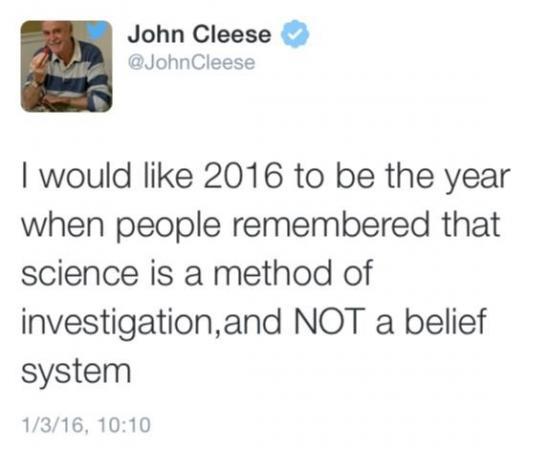
Mysterious radio signals from space are much better test of Einstein's General Relativity
January 4, 2016
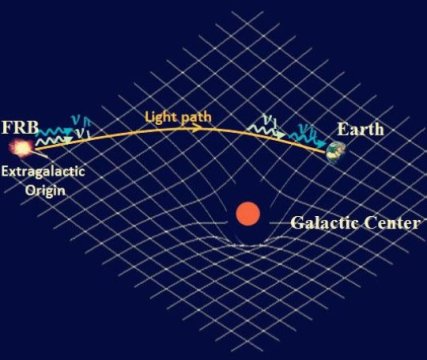
This illustration shows how two photons, one at a high frequency (nu_h) and another at a low frequency (nu_l), travel in curved space-time from their origin in a distant Fast Radio Burst (FRB) source until reaching the Earth. A lower-limit estimate of the gravitational pull that the photons experience along their way is given by the mass in the center of the Milky Way Galaxy. Credit: Purple Mountain Observatory, Chinese Academy of Sciences
A new way to test one of the basic principles underlying Einstein's theory of General Relativity using brief blasts of rare radio signals from space called Fast Radio Bursts is ten times, to one-hundred times better than previous testing methods that used gamma-ray bursts, according to a paper just published in the journal Physical Review Letters. The paper received additional highlighting as an "Editor's Suggestion" due to "its particular importance, innovation, and broad appeal," according to the journal's editors.
The new method is considered to be a significant tribute to Einstein on the 100th anniversary of his first formulation of the Equivalence Principle, which is a key component of Einstein's theory of General Relativity. More broadly, it also is a key component of the concept that the geometry of spacetime is curved by the mass density of individual galaxies, stars, planets, and other objects.
Fast Radio Bursts are super-brief blasts of energy -- lasting just a few milliseconds. Until now, only about a dozen Fast Radio Bursts have been detected on Earth. They appear to be caused by mysterious events beyond our Milky Way Galaxy, and possibly even beyond the Local Group of galaxies that includes the Milky Way. The new technique will be important for analyzing the abundance of observations of Fast Radio Bursts that advanced radio-signal observatories, now being planned, are expected to detect.
"With abundant observational information in the future, we can gain a better understanding of the physical nature of Fast Radio Bursts," said Peter Mészáros, Holder of the Eberly Family Chair in Astronomy and Astrophysics and Professor of Physics at Penn State, the senior author of the research paper. Like all other forms of electromagnetic radiation including visible light, Fast Radio Bursts travel through space as waves of photon particles. The number of wave crests arriving from Fast Radio Bursts per second -- their "frequency" -- is in the same range as that of radio signals. "When more-powerful detectors provide us with more observations," Mészáros said, "we also will be able to use Fast Radio Bursts as a probe of their host galaxies, of the space between galaxies, of the cosmic-web structure of the universe, and as a test of fundamental physics."
The impact of the new method using Fast Radio Bursts is expected to increase significantly as more of the bursts are observed, and if their origin can be established more firmly. "If Fast Radio Bursts are proven to originate outside the Milky Way Galaxy, and if their distances can be measured accurately, they will be a new powerful tool for testing Einstein's Equivalence Principle and for extending the tested energy range down to radio-band frequencies," Mészáros said.
Einstein's Equivalence Principle requires that any two photons of different frequencies, emitted at the same time from the same source and traveling through the same gravitational fields, should arrive at Earth at exactly the same time. "If Einstein's Equivalence Principle is correct, any time delay that might occur between these two photons should not be due to the gravitational fields they experienced during their travels, but should be due only to other physical effects," Mészáros said. "By measuring how closely in time the two different-frequency photons arrive, we can test how closely they obey Einstein's Equivalence Principle."
More specifically, Mészáros said the test that he and his coauthors developed involves an analysis of how much space curvature the photons experienced due to massive objects along or near their path through space. He said, "Our test of Einstein's Equivalence Principle using Fast Radio Bursts consists of checking by how much does a parameter -- the gamma parameter -- differ for the two photons with different frequencies."
Mészáros said his research team's analysis of the less-than-a-dozen recently detected Fast Radio Bursts "supersedes by one to two orders of magnitude the previous best limits on the accuracy of the Einstein Equivalence Principle," which were based on gamma rays and other energies from a 1987 supernova explosion, supernova 1987A. "Our analysis using radio frequencies shows that the Einstein Equivalence Principle is obeyed to one part in a hundred million," Mészáros said. "This result is a significant tribute to Einstein's theory, on the hundredth anniversary of its first formulation."
In addition to Mészáros, other authors of the paper include Jun-Jie Wei, a graduate student at the Purple Mountain Observatory of the Chinese Academy of Sciences; and two scientists who received their postdoctoral training with Mészáros at Penn State and who now hold academic and research positions in China, He Gao and Xue-Feng Wu, who is the paper's corresponding author.
This research is supported, in part, by the National Basic Research Program of China (2014CB845800 and 2013CB834900); NASA, the National Aeronautics and Space Administration of the United States (NNX 13AH50G), the National Natural Science Foundation of China (11322328 and 11433009), and the Chinese Academy of Sciences (2011231 and XDB09000000).
Jun-Jie Wei, He Gao, Xue-Feng Wu, Peter Mészáros. Testing Einstein’s Equivalence Principle With Fast Radio Bursts. Physical Review Letters, 2015; 115 (26) DOI:10.1103/PhysRevLett.115.261101
Plain packaging effective in reducing misperceptions of tobacco products among Australian Indigenous
December 29, 2015
Following the introduction of plain packaging on tobacco products in 2012, Australian Aboriginal and Torres Strait Islander people were 12 per cent less likely to think certain tobacco brands were less harmful than others, a new study found.
Plain packaging means tobacco company colours, logos and design elements are not allowed on tobacco products, but government health warnings still appear. Australia was the first country to implement plain packaging in December 2012 in an effort to curb national smoking rates. Canada plans to implement plain packaging as part of Prime Minister Trudeau's Safer Kids Initiative.
The research, published in the Australian and New Zealand Journal of Public Health, studied the effects of plain packaging on Australian Aboriginal and Torres Strait Islander people's perceptions of different brands being less harmful or more prestigious than others.
"We know that brand imagery and design elements influence perceptions of consumer risk and status," said Dr. Raglan Maddox, a postdoctoral fellow at the Li Ka Shing Knowledge Institute of St. Michael's Hospital, specializing in Aboriginal tobacco use, public health and evaluation. "Colours, shapes and symbols on packaging contribute to beliefs that certain brands are more high-status, while using words like mild, light or slim can give consumers the impression that some tobacco products are less harmful than others."
The study found plain packaging not only reduced overall misperceptions that there are healthier tobacco brands, but also found that participants under the age of 35 were 16.5 per cent less likely to view some brands as more prestigious than others. Research also indicates that smokers, especially those ages 18 to 29, found the new plain packs less appealing.
"These age-specific findings provide important insight for changing perceptions of status or prestige associated with tobacco brands in the younger indigenous population," said Dr. Maddox. "Preventing uptake and eliminating tobacco use in this demographic is central to addressing the disproportionate burden of smoking-related death and disease, while also improving overall health and life expectancy."
In 2013, approximately 42 per cent of Aboriginal and Torres Strait Islander people were smokers -- a substantially higher rate than the general population. Tobacco-related illness is the most preventable cause of disease and death in both Australian Aboriginal and non-Aboriginal people, contributing to heart disease, chronic respiratory disease and various forms of cancer.
Dr. Maddox said the study adds to growing literature indicating the world's first plain packaging initiative is associated with increased thoughts of smoking cessation, attempts to stop smoking and calls to cessation helplines.
"The findings are consistent with recent, broader research that smokers were more likely to correctly identify that cigarette brands are equally harmful and similar in prestige after plain packaging was implemented," said Dr. Maddox. "The findings on Australian Aboriginal and Torres Strait Islander people further support plain packaging and health warnings as an effective strategy in reducing global tobacco use."
As Canada and Australia are both Commonwealth countries with similar health and social systems, Dr. Maddox said he believes Australia's documented success combined with this study's findings could haves huge potential for Canadians -- especially vulnerable populations, which include First Nations, Inuit and Métis people.
Both countries observe much higher rates of smoking among Indigenous people than non-Indigenous citizens. According to Statistics Canada, First Nations, Inuit and Métis people are twice as likely to smoke or use tobacco products as non- Indigenous people. Among those who smoke, the majority started between the ages of 13 and 16 years of age.
Raglan Maddox, Sarah Durkin, Ray Lovett. Plain packaging implementation: perceptions of risk and prestige of cigarette brands among Aboriginal and Torres Strait Islander people.Australian and New Zealand Journal of Public Health, 2015; DOI:
Genetic changes in birds could throw light on human mitochondrial diseases
January 5, 2016
Deakin University and UNSW Australia researchers have made a rare observation of rapid evolution in action in the wild, documenting the spread of a newly arisen genetic mutation in invasive starlings, which could shed light on mitochondrial disease in humans.
The scientists found West Australian starlings carrying a particular mutation in their mitochondria, the energy powerhouses of cells, almost tripled their population within five years, suggesting the mutation was beneficial to the birds on the invasion front.
The first author of the study published in Molecular Biology and Evolution, Deakin University scientist Dr Lee Rollins, said the research was an important step forward in understanding how populations respond to a changing environment.
"Our findings also have important implications for mitochondrial diseases in humans, because this research significantly advances our understanding of how mitochondrial DNA mutations affect individuals and populations, and provides a potential mechanism to explain how different genetic variants may affect health," Dr Rollins said.
Dr Rollins, from Deakin's Centre for Integrative Ecology, within the School of Life and Environmental Sciences, said mitochondria were essential for sustaining life and had their own set of genes, usually only inherited from the mother.
"Sometimes mutations occur and an individual person or animal can end up having two different versions of mitochondrial genes within each cell," Dr Rollins said.
"This is surprisingly common and is associated with many inherited diseases in humans. But we know very little about how different mitochondrial genetic variants compete within individuals."
The research team, co-led by Dr Rollins and Professor Bill Sherwin of UNSW, in collaboration with the Department of Agriculture and Food in Western Australia, studied the DNA of 279 starlings near Munglinup in the south east of Western Australia and identified birds with a novel mitochondrial genome sequence (Haplotype H).
This genetic variant is not present in starlings living elsewhere in the country, so is likely to have arisen in this particular population at the invasion front.
Professor Sherwin, of the UNSW School of Biological, Earth and Environmental Sciences, said the advantageous mutation then spread rapidly through the population, with the proportion of birds carrying Haplotype H increasing from 17 per cent to 47 per cent during the five years of the study.
"We also showed haplotype H was associated with a reduction in the number of copies of the mitochondrial DNA in cells, which might indicate that mitochondria in those cells are more efficient," Professor Sherwin said.
"Biological phenomena are often like the Emperor's new clothes: everybody knows they should be there, but no-one can see them. We have found evidence of a seldom seen, but often discussed phenomenon, providing the first demonstration of rapid evolutionary selection on the mitochondrial genome within individuals in the wild, as a result of an invasive species moving into new territory."
Starlings are considered one of the world's worst invasive alien species, and have been likened to "cane toads with wings" in Australia.
They pose a serious threat to agriculture and the environment and the West Australian government has attempted to eradicate starlings for decades.
"Invasive species usually find themselves in environments where they face novel challenges, and new mutations can help solve these new problems. Our study is one of the first to track this rapid change at a molecular level," Professor Sherwin said.
The team's previous genetic work on the starlings helped inform management strategies in WA, by revealing the state's invasion population did not interbreed much with the three other main populations of starlings in the rest of Australia, indicating that localised control in WA could be effective.
Selection on mitochondrial variants occurs between and within individuals in an expanding invasion
Lee A. Rollins1, Andrew P. Woolnough, Benjamin G. Fanson, Michelle L. Cummins, Tamsyn M. Crowley, Alan N. Wilton, Ron Sinclair, Ashleigh Butler and William B. Sherwin.Mol Biol Evol (2016) doi: 10.1093/molbev/msv343. First published online: January 6, 2016
Total Wellbeing Diet online with Dietitian Plus Launched
5 January, 2016: CSIRO
Australians are their own worst enemies when it comes to eating better and controlling their weight, according to findings from a new survey by the CSIRO Total Wellbeing Diet online.
The survey, which looked at the weight management habits of more than 2300 Australians, found 69 per cent of respondents identified themselves as the main barrier to achieving their weight loss goals.
CSIRO conducted the survey to better understand why some Australians were more successful at dieting than others.
It looked at a cross section of dieters – from those who were successful, unsuccessful, about to start the weight loss journey and currently in the process of managing their weight.
The survey found self-sabotaging dieters pointed to social activities (52 per cent), high stress (41 per cent), lack of motivation (41 per cent), eating out (37 per cent) and limited weight loss (36 per cent) as barriers to losing weight.
CSIRO’s Research Director for Nutrition and Health and co-author of the CSIRO Total Wellbeing Diet online Professor Manny Noakes said it was critical that those looking to lose weight seek support.
“For many Australians losing weight is a challenging experience,” Professor Noakes said.
“In addition to hampering their own efforts, the survey also showed that 40 per cent of dieters stated that no one supports them in their weight loss attempts.
“Health professionals, friends and family can all play a role in helping dieters eat better and control their weight.”
In conjunction with the survey findings, the CSIRO Total Wellbeing Diet online today launched Dietitian Plus, a new service which provides personalised support from Accredited Practising Dietitians (APD) to help dieters reach their weight loss goals.
Dietitian Plus includes 12 weeks of the Total Wellbeing Diet online program plus online one-on-one support from university-trained dietitians to assist dieters during those critical times of their weight loss journey.
Dietitians will share their expert advice on nutrition, offer personalised support and feedback, help dieters set realistic and achievable weight loss goals and establish a high level of accountability.
Total Wellbeing Dietitian Nicole Dynan said Dietitian Plus was a comfortable and convenient way for those wanting to lose weight to receive professional advice and support.
“We can use the time to help them plan for success, monitor their progress or even create their shopping list to stock their fridge or pantry,” Ms Dyan said.
“The session can also be used to identify triggers or events that lead to overeating and ways to overcome them.”
Total Wellbeing Diet online is one of the first commercial weight loss programs to connect those wanting to lose weight with Accredited Practising Dietitians.
The Total Wellbeing Diet online and Dietitian Plus is available for $299 and includes the 12-week scientifically formulated online program including personalised meal and exercise plans, as well as support and motivation from a team of dietitians via online face-to-face sessions and over telephone and email.
Additional survey findings include:
• Half (50 per cent) of those who had tried dieting but had since given up cited a lack of drive had hampered their weight management attempt, while 56 per cent said ‘life getting in the way’ had proven to be their biggest hurdle.
• Respondents want to lose an average of 11 per cent of their body weight within the next six months, which equates to an average of 9.4kgs.
• 1 in 5 respondents believed they would fail in their weight loss goals during the next six months.
• 31 per cent said achieving their weight loss goals was out of their control.
To find out more about Dietitian Plus visit:www.totalwellbeingdiet.com
Optical coherence tomography may speed detection of pneumonia-related bacteria in ICU patients
January 5, 2016
The ability to better detect and assess bacteria linked to a form of pneumonia prevalent in hospital intensive care units (ICUs) could soon become possible, according to research reported in the latest issue of the Journal of Biomedical Optics. The journal is published by SPIE, the international society for optics and photonics.
Andrew Heidari and other researchers at the University of California Irvine, the Beckman Laser Institute, and N8 Medical demonstrated that optical coherence tomography (OCT) can be used to determine the presence of biofilm -- bacterial growth that results from the attachment and subsequent multiplication of microorganisms to a synthetic surface.
Biofilm has been linked to ventilator-associated pneumonia (VAP), which is a prevalent infection in hospital intensive care units (ICUs). Using OCT, the team was able to visualize and assess the extent of airway obstruction from biofilm deposited on intubated endotracheal tubes in vivo.
"This is a newsworthy application for those working in the ICU," said David Sampson of the University of Western Australia. "Infection is an ever-present risk, and an easier way to check for biofilm could see such checks done more often and infection rates lowered, which would be a great outcome."
The current method for biofilm characterization utilizes scanning electron microscopy (SEM), a lengthy process that requires extracting a sample, drying it, and coating it with a thin gold layer, none of which can be performed in vivo.
OCT, on the other hand, is a noninvasive imaging technology that can provide high-resolution cross-sectional images of various biological samples, and can be adapted to provide three-dimensional volumetric information.
In this study, extubated patients' endotracheal tubes were imaged using both OCT and SEM. Biofilm was present in both images, and the researchers were able to use the OCT image to measure a reduction in endotracheal inner lumen area between a 1-day intubation sample tube and a 5-day sample tube.
The study showed that OCT can be used to both detect the presence of biofilm and gather further information about the extent of biofilm formation from the thickness of biofilm observed.
In the future, the research group plans to use OCT images to analyze the thickness and structure of the biofilm at which intubated patients in the ICU contract VAP.
Andrew E. Heidari, Samer Moghaddam, Kimberly K. Troung, Lidek Chou, Carl Genberg, Matthew Brenner, Zhongping Chen.Visualizing biofilm formation in endotracheal tubes using endoscopic three-dimensional optical coherence tomography.Journal of Biomedical Optics, 2015; 20 (12): 126010 DOI:10.1117/1.JBO.20.12.126010
Self-esteem gender gap more pronounced in western nations
January 4, 2016
People worldwide tend to gain self-esteem as they grow older, and men generally have higher levels of self-esteem than women, but this self-esteem gender gap is more pronounced in Western industrialized countries, according to research published by the American Psychological Association.
"During the past two decades, a large number of studies on age and gender differences in self-esteem have found that men have higher self-esteem than women and that both men and women show age-graded increases in self-esteem. These robust findings would appear to provide a solid empirical foundation upon which researchers can develop their understanding of the mechanisms driving age and gender differences in self-esteem," said lead author Wiebke Bleidorn, PhD, of the University of California, Davis. "However, one issue potentially undermines this conclusion: Virtually all previous studies have only examined samples from Western, educated, industrialized, rich, and democratic countries. Our research aims to provide the first systematic cross-cultural examination of gender and age effects on self-esteem."
The study was published in the Journal of Personality and Social Psychology.
Bleidorn and her colleagues analyzed survey data from over 985,000 men and women ages 16-45 from 48 countries. The data were collected from July 1999 to December 2009 as part of the Gosling-Potter Internet Personality Project. The researchers compared self-reported self-esteem, gender and age across the 48 nations in their study.
In general, the researchers found that self-esteem tended to increase with age, from adolescence to adulthood, and that men at every age tended to have higher levels of self-esteem than women worldwide. When they broke the results down by country, they found some interesting results.
"Specifically, individualistic, prosperous, egalitarian, developed nations with higher gender equality had larger gender gaps in self-esteem than collectivist, poorer, developing nations with greater gender inequality," said Bleidorn. "This is likely the result of specific cultural influences that guide self-esteem development in men and women."
For instance, the gender differences were small in many Asian countries, such as Thailand, Indonesia and India, but were relatively larger in countries like the United Kingdom or the Netherlands.
What surprised the researchers most was, despite the cultural differences, the general trend across all the countries suggests that gender and age differences in self-esteem are not a Western idiosyncrasy, but can be observed in different cultures across the world.
"This remarkable degree of similarity implies that gender and age differences in self-esteem are partly driven by universal mechanisms; these can either be universal biological mechanisms such as hormonal influences or universal cultural mechanisms such as universal gender roles. However, universal influences do not tell the whole story," said Bleidorn. "The differences in magnitude and shape of gender and age differences in various countries provide strong evidence for culture-specific influences on the development of self-esteem in men and women."
These findings are important because up until now the bulk of research on self-esteem has been confined to industrialized, Western cultures where the gender gap is significantly greater, said Bleidorn. "This new research refines our understanding of how cultural forces may shape self-esteem, which, when worked out more fully, can help inform self-esteem theory and design interventions to promote or protect self-esteem."
Wiebke Bleidorn, Ruben C. Arslan, Jaap J. A. Denissen, Peter J. Rentfrow, Jochen E. Gebauer, Jeff Potter, Samuel D. Gosling. Age and Gender Differences in Self-Esteem—A Cross-Cultural Window..ournal of Personality and Social Psychology, 2015; DOI:10.1037/pspp0000078
Taking vitamin D may benefit people with multiple sclerosis
January 4, 2016
Taking a high dose of vitamin D3 is safe for people with multiple sclerosis and may help regulate the body's hyperactive immune response, according to a pilot study published by Johns Hopkins physicians in the Dec. 30 online issue of Neurology, the medical journal of the American Academy of Neurology.
"These results are exciting, as vitamin D has the potential to be an inexpensive, safe and convenient treatment for people with MS," says study author Peter Calabresi, M.D., director of the Johns Hopkins Multiple Sclerosis Center and professor neurology at the Johns Hopkins University School of Medicine. "More research is needed to confirm these findings with larger groups of people and to help us understand the mechanisms for these effects, but the results are promising."
Low levels of vitamin D in the blood are tied to an increased risk of developing MS. People who have MS and low levels of vitamin D are more likely to have greater disability and more disease activity.
For the study, 40 people with relapsing-remitting MS received either 10,400 international units or 800 international units of vitamin D3 supplements per day for six months. Patients with severe vitamin D deficiency were not included in the study. The current recommended daily allowance of vitamin D3 is 600 international units. Blood tests at the start of the study and again at three and six months measured the amount of vitamin D in the blood and the response in the immune system's T cells, which play a key role in MS.
While researchers are still determining the optimal level of vitamin D in the blood for people with MS, a suggested range of 40 to 60 nanograms per milliliter (ng/ml) has been proposed as a target. Participants taking the high dose of vitamin D reached levels within the proposed target, whereas the group taking the low dose did not reach the target.
Side effects from the vitamin supplements were minor and were not different between the people taking the high dose and the people taking the low dose. One person in each group relapsed.
The people taking the high dose had a reduction in the percentage of inflammatory T cells related to MS severity, specifically IL-17+CD4+ and CD161+CD4+ cells. When the increase in vitamin D levels in the blood over base line levels was greater than 18 ng/ml, every additional 5 ng/ml increase in vitamin D led to a 1 percent decrease in the percentage of IL-17+CD4+ T cells in the blood. The people taking the low dose did not have any noticeable changes in the percentages of their T cell subsets.
"We hope that these changes in inflammatory T cell responses translate to a reduced severity of disease," says Calabresi. "Other clinical trials are underway to determine if that is the case."
E. S. Sotirchos, P. Bhargava, C. Eckstein, K. Van Haren, M. Baynes, A. Ntranos, A. Gocke, L. Steinman, E. M. Mowry, P. A. Calabresi.Safety and immunologic effects of high- vs low-dose cholecalciferol in multiple sclerosis. Neurology, 2015; DOI:10.1212/WNL.0000000000002316
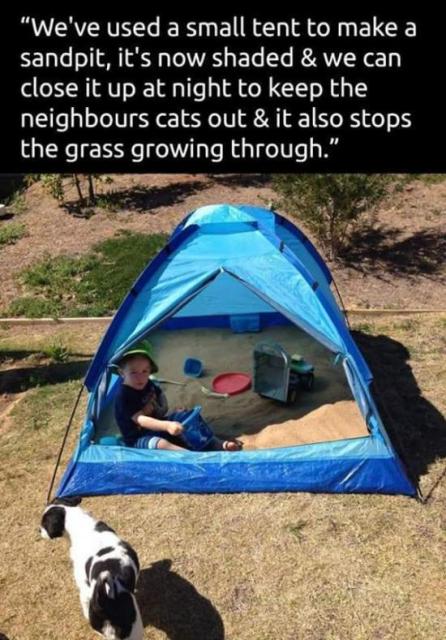
Disclaimer: These articles are not intended to provide medical advice, diagnosis or treatment. Views expressed here do not necessarily reflect those of Pittwater Online News or its staff.